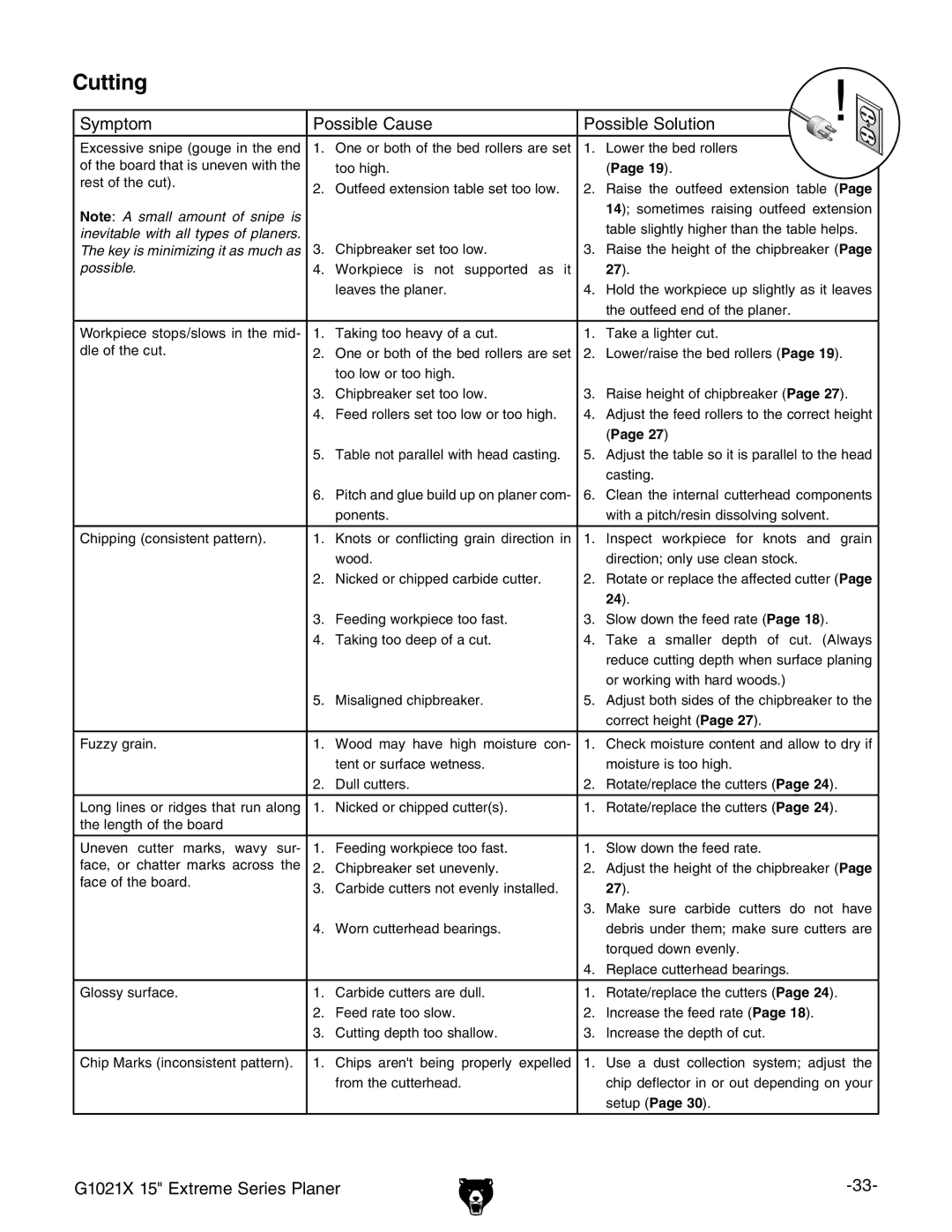
Cutting
Symptom | Possible Cause | Possible Solution | |||
|
|
|
|
| |
Excessive snipe (gouge in the end | 1. | One or both of the bed rollers are set | 1. | Lower the bed rollers | |
of the board that is uneven with the |
| too high. |
| (Page 19). | |
rest of the cut). | 2. | Outfeed extension table set too low. | 2. | Raise the outfeed extension table (Page | |
| |||||
Note: A small amount of snipe is |
|
|
| 14); sometimes raising outfeed extension | |
|
|
| table slightly higher than the table helps. | ||
inevitable with all types of planers. |
|
|
| ||
3. | Chipbreaker set too low. | 3. | Raise the height of the chipbreaker (Page | ||
The key is minimizing it as much as | |||||
possible. | 4. | Workpiece is not supported as it |
| 27). | |
|
| leaves the planer. | 4. | Hold the workpiece up slightly as it leaves | |
|
|
|
| the outfeed end of the planer. | |
|
|
|
|
| |
Workpiece stops/slows in the mid- | 1. | Taking too heavy of a cut. | 1. | Take a lighter cut. | |
dle of the cut. | 2. | One or both of the bed rollers are set | 2. | Lower/raise the bed rollers (Page 19). | |
|
| too low or too high. |
|
| |
| 3. | Chipbreaker set too low. | 3. | Raise height of chipbreaker (Page 27). | |
| 4. | Feed rollers set too low or too high. | 4. | Adjust the feed rollers to the correct height | |
|
|
|
| (Page 27) | |
| 5. | Table not parallel with head casting. | 5. | Adjust the table so it is parallel to the head | |
|
|
|
| casting. | |
| 6. | Pitch and glue build up on planer com- | 6. | Clean the internal cutterhead components | |
|
| ponents. |
| with a pitch/resin dissolving solvent. | |
|
|
|
|
| |
Chipping (consistent pattern). | 1. | Knots or conflicting grain direction in | 1. | Inspect workpiece for knots and grain | |
|
| wood. |
| direction; only use clean stock. | |
| 2. | Nicked or chipped carbide cutter. | 2. | Rotate or replace the affected cutter (Page | |
|
|
|
| 24). | |
| 3. | Feeding workpiece too fast. | 3. | Slow down the feed rate (Page 18). | |
| 4. | Taking too deep of a cut. | 4. | Take a smaller depth of cut. (Always | |
|
|
|
| reduce cutting depth when surface planing | |
|
|
|
| or working with hard woods.) | |
| 5. | Misaligned chipbreaker. | 5. | Adjust both sides of the chipbreaker to the | |
|
|
|
| correct height (Page 27). | |
|
|
|
|
| |
Fuzzy grain. | 1. | Wood may have high moisture con- | 1. | Check moisture content and allow to dry if | |
|
| tent or surface wetness. |
| moisture is too high. | |
| 2. | Dull cutters. | 2. | Rotate/replace the cutters (Page 24). | |
|
|
|
|
| |
Long lines or ridges that run along | 1. | Nicked or chipped cutter(s). | 1. | Rotate/replace the cutters (Page 24). | |
the length of the board |
|
|
|
| |
|
|
|
|
| |
Uneven cutter marks, wavy sur- | 1. | Feeding workpiece too fast. | 1. | Slow down the feed rate. | |
face, or chatter marks across the | 2. | Chipbreaker set unevenly. | 2. | Adjust the height of the chipbreaker (Page | |
face of the board. | 3. | Carbide cutters not evenly installed. |
| 27). | |
|
| ||||
|
|
| 3. | Make sure carbide cutters do not have | |
| 4. | Worn cutterhead bearings. |
| debris under them; make sure cutters are | |
|
|
|
| torqued down evenly. | |
|
|
| 4. | Replace cutterhead bearings. | |
|
|
|
|
| |
Glossy surface. | 1. | Carbide cutters are dull. | 1. | Rotate/replace the cutters (Page 24). | |
| 2. | Feed rate too slow. | 2. | Increase the feed rate (Page 18). | |
| 3. | Cutting depth too shallow. | 3. | Increase the depth of cut. | |
|
|
|
|
| |
Chip Marks (inconsistent pattern). | 1. | Chips aren't being properly expelled | 1. | Use a dust collection system; adjust the | |
|
| from the cutterhead. |
| chip deflector in or out depending on your | |
|
|
|
| setup (Page 30). | |
|
|
|
|
| |
G1021X 15" Extreme Series Planer |
